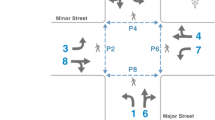Abstract
This paper deals with an offset control of traffic signals using a cellular automaton traffic model. A stochastic optimal control method for distributed traffic signals is modified to achieve coordinated traffic signal control with the proposed offset control method. In the proposed coordinated traffic signal control method, splits of each cycle and common cycle length are calculated using a modified stochastic optimal control method, and then the offset is calculated using an estimation method based on a modified CA traffic model at intervals. Also, simulations are carried out at multiple intersections using a micro traffic simulator. The effectiveness of the proposed coordinated control method is proved by comparing with other traffic signal control methods such as pre-timed signal control, two types of the traditional coordinated control and distributed control.








Similar content being viewed by others
References
Robertson DI, Bretherton RD (1991) Optimizing networks of traffic signals in real time, the SCOOT method. IEEE Trans Veh Technol 40(1):11–15
AG Sims, KW Dobinson (1980) The Sydney coordinated adaptive traffic (SCAT) system philosophy and benefits. IEEE Trans Veh Technol 29(2):130–137
Cui C-Y, Shin J-S, Shoji F, Lee H-H (2009) Traffic signal control based on a predicted traffic jam distribution. J Artif Life Robot 14(2):134–137
Cui C-Y, Shin J-S, Miyazaki M, Lee H-H (2013) Real-time traffic signal control for optimization of traffic jam probability. Electron Commun Jpn 96(1):1–13
Japan Society of Traffic c Engineers (2006) Manual on traffic c signal control. MARUZEN, Japan
Webster FV, Cobbe BM (1958) Traffic signals, “Road Research Technical Report 39”. Her Majesty’s Stationery Office, London
Kennedy J, Eberhart R (1995) Particle swarm optimization. In: Proceedings IEEE international conference on neural networks, pp 19842–11948
Janson S, Middendorf M (2005) A hierarchical particle swarm optimizer and its adaptive variant. IEEE Trans Syst Man Cybern 35(6):1272–1282
Jin H, Cui C, Lee H (2013) A micro-simulator for traffic signal control based on a modified cellular automaton traffic flow model. In: Proceedings of the eighteenth international symposium on artificial life and robotics, pp 21–24
Acknowledgements
This work was supported by “National Natural Science Foundation of China (Grant No. 71461026)”, “Science and Technology Development Plan of Yanbian University (No. 602014072)”, and “12th Five Year Plan of Jilin Provincial Department of Education (2015)”.
Author information
Authors and Affiliations
Corresponding author
About this article
Cite this article
Cui, C., Kui, Z., Lee, H. et al. Offset control of traffic signal using cellular automaton traffic model. Artif Life Robotics 22, 145–152 (2017). https://doi.org/10.1007/s10015-017-0356-3
Received:
Accepted:
Published:
Issue Date:
DOI: https://doi.org/10.1007/s10015-017-0356-3




